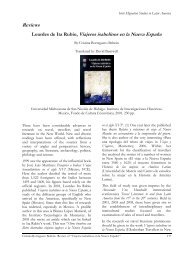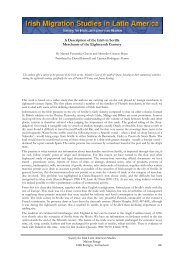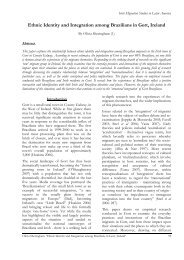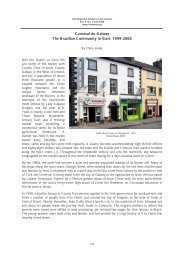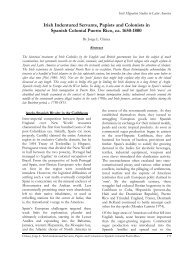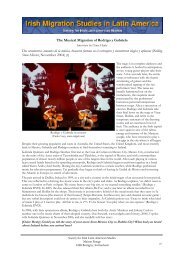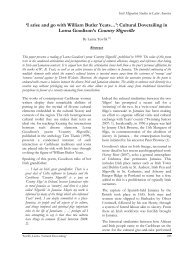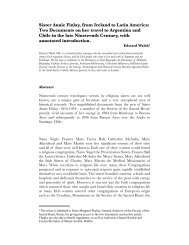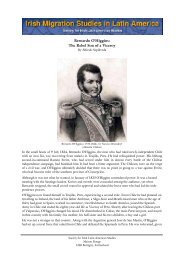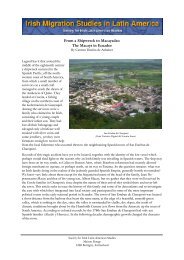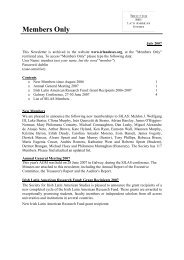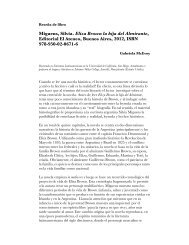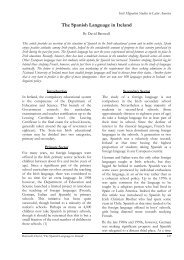I:6 Anti-dumping - Society for Irish Latin American Studies
I:6 Anti-dumping - Society for Irish Latin American Studies
I:6 Anti-dumping - Society for Irish Latin American Studies
You also want an ePaper? Increase the reach of your titles
YUMPU automatically turns print PDFs into web optimized ePapers that Google loves.
At end of 1881, Michael Dineen, who had ample teaching experience [25] , announced to the readers of<br />
The Southern Cross that, on popular request, he would open on January 15, 1882, the a<strong>for</strong>e mentioned<br />
school <strong>for</strong> boys, and presented an ambitious curriculum. However, on January 13, 1883, he dispelled the<br />
illusions of the <strong>Irish</strong>-Argentine parents:<br />
“Owing to the fact that Mr. Michael Dineen, having been appointed co-editor of the Southern Cross, cannot carry<br />
his intention of opening a college in San Pedro, he takes this opportunity of thanking the many friends who<br />
generously offered their patronage and support.” [26]<br />
Henry Gray (1850-1928), member of the Congregation of Saint Vincent of Paul (Lazarists) opened in<br />
1877 the Colegio de Nuestra Señora de Luján, in Luján, 60 km. north of the city of Buenos Aires. [27] Its<br />
purpose was to give “a true Christian education and sound instruction to those young men who are<br />
desirous of following the ecclesiastical career or any profession, whether of the free or commercial style”.<br />
[28]<br />
The prospectus spared no details, describing the subjects, conditions <strong>for</strong> admission (which included the<br />
presentation of various certificates: birth, good conduct, health) and also the boys’ wardrobe (it even<br />
specifies the number of socks that they had to bring along!).<br />
The Sisters of Mercy<br />
After intense negotiations, the Sisters of Mercy agreed to come back to Argentina, arriving in Buenos Aires<br />
in August 1890. In 1883, eminent <strong>Irish</strong>-Argentine citizens had founded the <strong>Irish</strong> Catholic Association<br />
(ICA) which had taken over the school in Riobamba Street.<br />
Up to that moment, the free school <strong>for</strong> humble and orphaned girls, the school <strong>for</strong> boarders and the<br />
convent shared the same premises. The 1895 national census shows that 18 sisters were in charge of 136<br />
students, which were still mostly <strong>Irish</strong>-Argentine. [29] The building was rapidly becoming inadequate, and<br />
it was sold to the Brothers of the Christian Schools, who founded the La Salle School, which still stands to<br />
this day.<br />
The <strong>Irish</strong> Catholic Association and the Sisters of Mercy decided to go separate ways: the association<br />
started building Saint Bridget’s School, while the Sisters began to build on the corner of 24 de Noviembre<br />
and Estados Unidos, the building which would serve as convent and Mater Misericordiae School.<br />
Mater Misericordiae was solemnly inaugurated on August 15, 1897. The Sisters would run this establishment<br />
<strong>for</strong> almost 8 years, always seeking to teach Christian values, solid knowledge, physical health and<br />
good manners. Many other Mercy schools followed in the next two decades.<br />
At the beginning of the 20 th century, two <strong>Irish</strong>-Argentine ladies decided it was necessary to create <strong>Irish</strong><br />
schools in San Antonio de Areco, a prosperous town in the northern area of the province of Buenos Aires.<br />
Santa María de la Asunción (Saint Mary’s) and Clonmacnoise stand as testimonies of the generosity of Mary<br />
Mooney and her sister Margaret Morgan (née Mooney), respectively.<br />
Saint Mary’s -a girls’ school- was inaugurated on 16 March 1901. Mrs. Morgan had intended to find a<br />
male order to run the boys’ school baptised after the well-known monastery of Ireland’s golden age.<br />
Clonmacnoise opened its doors on 22 March 1922 and was run by the Sisters of Mercy until 1949, when<br />
the nuns decided to entrust its care to the Pallotine fathers. Both schools benefited from its easy access by<br />
train and the increasing amount of <strong>Irish</strong> settlers in the area.<br />
The railway would also contribute to the creation of another school. This time it would be in Rawson<br />
(Chacabuco department). Mrs. Mary Anne Browne Casey, graciously donated a house in which the<br />
daughters of the <strong>Irish</strong> railway workers could be educated. The Sisters inaugurated Saint Anne’s on 19 April<br />
1929. [30] Two years later, they established Saint Ethnea’s, in Bella Vista, in the outskirts of Buenos Aires.<br />
Meanwhile, the <strong>Irish</strong> Catholic Association decided that the new school should be an everlasting tribute to<br />
the memory of Father Fahy. With that purpose in mind, the ICA bought 7 hectares in the area of Flores<br />
(at that time, the outskirts of the city). The construction of the new building, executed by Inglis &<br />
Thomas, caused a big stir in the community and was closely monitored by The Southern Cross.<br />
The result was a grandiose neo-gothic building. Saint Bridget’s, so christened after the patron saint of<br />
Ireland and of students, which was inaugurated in the presence of hundreds of <strong>Irish</strong>-Argentines by the<br />
archbishop of Buenos Aires, Mgr. Castellanos, on March 19, 1899. The building, which is 3-stories high,<br />
María José Roger, The Children of the Diaspora .................................................................................. 9



